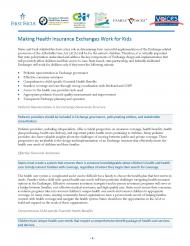As we have worked with our national and state partners on implementation of the Affordable Care Act over the last few years, we have grown more and more concerned about children in the Exchanges.
After more than a decade of declines in uninsurance rates for children, it is imperative that Congress, the administration, state policymakers, and children’s advocates work together so we do not  lose the gains we’ve made as implementation of the Affordable Care Act (ACA) moves forward. This document identifies key principles to ensure that the health insurance Exchanges (marketplaces) do, in fact, work for all children so we do not lose ground. It addresses our key questions about the Exchanges: How will children fare in the Exchanges (state-based and federally facilitated)? What safeguards need to be in place to protect children’s coverage and meet their physical and developmental needs? How should children’s needs be addressed in all aspects of the Exchanges?
lose the gains we’ve made as implementation of the Affordable Care Act (ACA) moves forward. This document identifies key principles to ensure that the health insurance Exchanges (marketplaces) do, in fact, work for all children so we do not lose ground. It addresses our key questions about the Exchanges: How will children fare in the Exchanges (state-based and federally facilitated)? What safeguards need to be in place to protect children’s coverage and meet their physical and developmental needs? How should children’s needs be addressed in all aspects of the Exchanges?
Together with the help of Lincoln Nehring from Voices for Utah Children, we have answered those questions. We believe that the Exchanges can work for children if they:
- Include pediatric representation in their governance and oversight structures
- Have effective consumer assistance to reach families with children
- Include strong benefit packages that meet children’s needs
- Ensure seamless coverage and care and coordination with Medicaid and CHIP
- Include provider networks with the right providers for kids
- Include quality and improvement measures focused on kids
- Be transparent in their planning and operation
We are sharing this brief with our state partners, our national partners, all members of Congress, and the Administration. Our hope is that children’s unique health needs will be addressed in every aspect of Exchange design and implementation, beginning with the federal regulations written here in Washington, to the very specific ways states will implement their Exchange rules and protocols, to the oversight and monitoring that must happen at the federal and state levels.